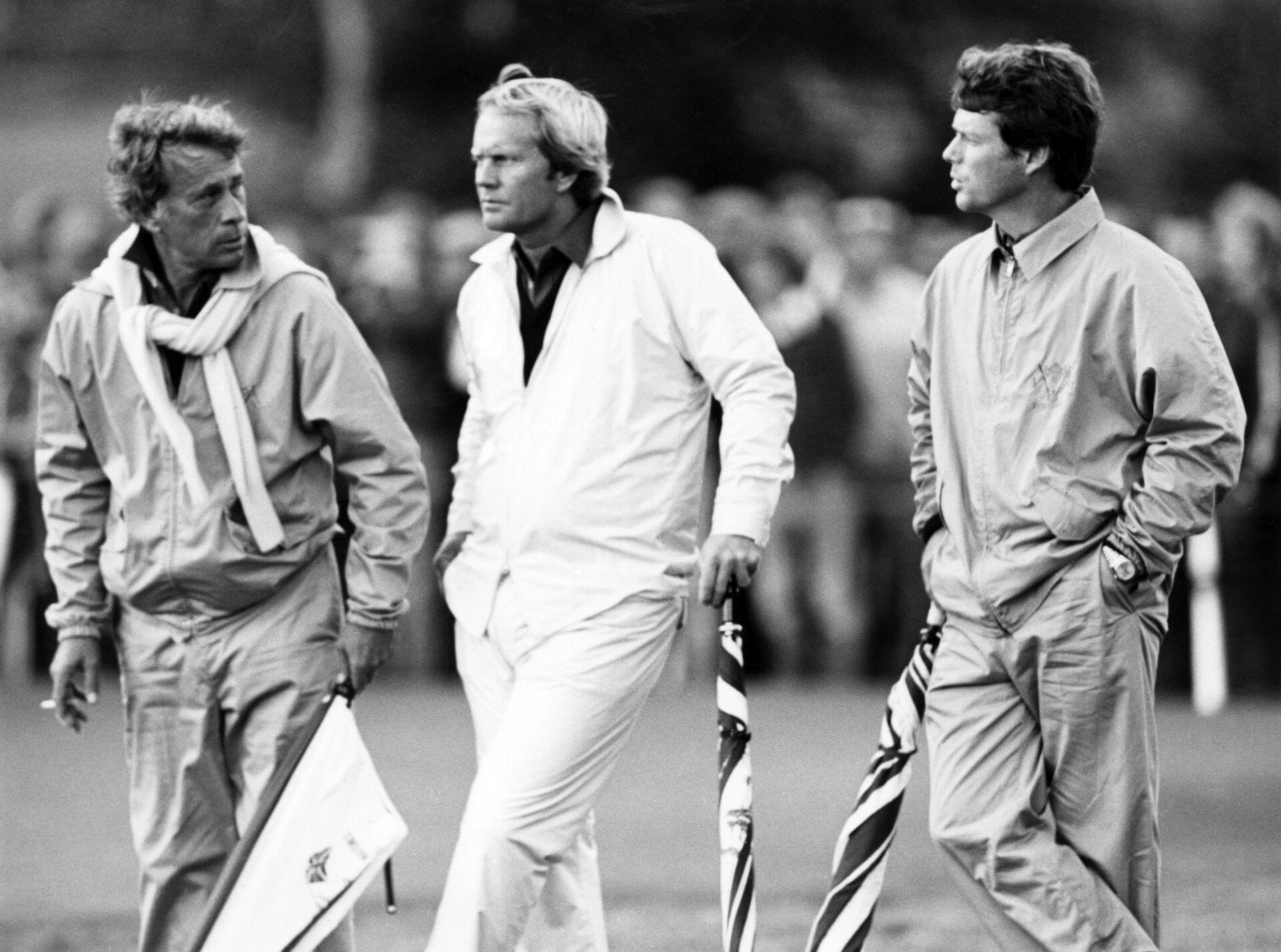It’s virtually impossible to create a “golf’s greatest” list without including Jack Nicklaus. Yet, for all his incredible achievements with club in hand, Jack’s greatest contributions to golf’s greatest team event have both come in a different fashion.
Born in Columbus, Ohio in 1940, Nicklaus first took up the game aged 10, discovering he had an incredible natural aptitude for the sport. Within three years he was a plus-three handicap, within six years he won the Ohio Open (beating many professionals in the process), within seven years he qualified for his first of 44 consecutive US Opens, and within eight years he had made his PGA Tour debut, tying for 12th place.
While attending Ohio State University, Nicklaus twice won the US Amateur title, won the NCAA Championship, and finished solo-second behind Arnold Palmer at the 1960 US Open. Any lingering doubts as to the prodigious talent of the strongly-built Mid-westerner were quickly dispelled when Nicklaus – having turned professional in late 1961 – turned the tables on Palmer at the 1962 US Open at Oakmont, winning an 18-hole playoff against “The King,” much to the consternation of the travelling and boisterous Arnie’s Army.
In those days, American players had to serve a five-year PGA Tour apprenticeship before being eligible for Ryder Cup selection. Jack – whose solid frame and bright blonde locks had earned the nickname “The Golden Bear” – wasn’t granted full PGA Tour membership until June 1966, leaving him a limited time frame in which to accumulate points for the 1967 Ryder Cup. When qualification ended after the 1967 Masters Tournament, six months and change before the Ryder Cup would take place, Nicklaus found himself in 13th place in the rankings, despite winning three tournaments including an Open Championship in the previous nine months.
By the time Nicklaus made his Ryder Cup debut at Birkdale in 1969, he was a seven-time major champion with a further eight second-place finishes, and comfortably regarded as the best player in the world. In a US side featuring ten rookies, Nicklaus found himself in the anchor match of the afternoon singles against reigning Open champion Tony Jacklin. A six-session series in those days, the final day saw two sets of eight singles matches, and ironically, Nicklaus and Jacklin had squared off earlier in the day as well, with the latter securing a 4-and-3 win for Great Britain and Ireland.
Upon reaching the final hole, it was evident that whoever won the 18th would win not just the match but would clinch the Ryder Cup for their respective side. Faced with four-and-a-half feet for par with Jacklin a good 18-inches closer, Nicklaus buried his par putt and then lifted Jacklin’s ball marker, conceding the putt and uttering the now immortal words “I don’t think you’d have missed it but I wasn’t going to give you the chance.”
As anybody that has ever played golf knows, three-footers can be tricky at the best of times, but in the pressure cooker of a Ryder Cup and with your nation’s fate in your hands, Jacklin’s putter would’ve felt as rigid and trustworthy as a serpent.
To this day, “The Concession” as it has become known is one of the greatest displays of sportsmanship in the history of competitive sport. Not that all agreed with Nicklaus’ choice, however. United States captain Sam Snead was reportedly furious with The Golden Bear for not forcing Jacklin to hole-out and potentially depriving the Americans of a sixth successive victory.
Jack himself wouldn’t have long to wait for his first Ryder Cup success, posting five wins and one defeat as normal service was resumed at Old Warson Country Club in St. Louis, Missouri and followed this in 1973 with a 4-1-1 performance at Muirfield in Scotland in another American rout.
By the time the competition returned Stateside in 1975, Nicklaus’ major haul numbered 13, failing to break the top-10 just twice in the last 24 majors played. The competitive edge is what Jack craved most and this had been sadly lacking in the team event since Nicklaus and Jacklin had embraced on Birkdale’s 18th green six years earlier. With two-and-a-half points from three matches heading into the singles, Jack found himself in the anchor match once more in both singles sessions, but the event was effectively over before the final day commenced and definitively over before the final session began. Quite how this affected Nicklaus’ play and mindset is hard to calculate, but he lost to Brian Barnes in both sessions as Britain and Ireland rallied late but still lost by ten points.
The 1975 win was America’s eighth in nine Ryder Cups and Nicklaus – like many other top American players – was fast losing interest. The competition committee shortened the event to 18 matches (from 32) in efforts to curtail United States dominance, but this was merely papering over the cracks as the United States made light of the shortened format to record another comfortable win. It was here that Nicklaus’ second great Ryder Cup act would take place, ironically coinciding with his most lacklustre performance as a player.
The Golden Bear reached out to British PGA figurehead Lord Derby during the event at Royal Lytham and St. Annes. For the Ryder Cup to remain competitive, Nicklaus argued, the British and Irish side would have to be expanded. And there’s no denying the logic. At the time, the United States outgunned Britain and Ireland by 15 to 1 in terms of golfers, and Nicklaus recognised that in Seve Ballesteros, continental Europe had a bona fide star and several more in the making.
Of course, Jack was not alone in recognising that change was not just desirable, but crucial for the event’s future, but it was his standing and diplomacy that were the deciding factors in Ryder Cup reform to something resembling its current state.
Sadly, despite being the main driving force behind European inclusion, The Bear was conspicuous by his absence at the first United States versus Europe match in 1979. Despite posting three major top-10s, Nicklaus played just 12 PGA Tour events in 1979 and didn’t qualify.
Jack’s final Ryder Cup appearance as a player would come at Walton Heath in 1981 against new-look opposition that included Spaniards José Maria Cañizares and Manuel Piñero and German Bernhard Langer. Unfortunately, due to a dispute with the European Tour regarding appearance money, Ballesteros didn’t play in ’81, never getting to share the stage with the man most responsible for his invitation.
Perhaps sensing it would be his last Ryder Cup, Nicklaus produced arguably his greatest Cup performance, teaming up with Tom Watson to go three for three, before signing off with a comprehensive singles win over Eamonn Darcy.
Though Jack’s Ryder Cup playing days were over, he was awarded the captaincy for the 1983 staging at the Nicklaus designed PGA National in Palm Beach. The closest Ryder Cup since 1969 and among the greatest ever played, 14 of the 24 players would win major titles during their careers, with the scores level after the first, third and fourth sessions. Tom Watson’s 2-and-1 win over Bernard Gallacher in the final match earned the United States the victory by the narrowest possible margin. In a way, this was the perfect result. Nicklaus’ vision had been verified, the lustre of the Cup restored, and he was spared the humiliation of being the first losing US captain since 1957.
That misfortune befell Jack’s great rival Lee Trevino in 1985 as a Seve inspired Europe claimed a resounding victory at The Belfry, before The Bear came out of hibernation to take the reins once more in ’87 in his home state of Ohio. Again, Ballesteros proved the difference, taking four points from a possible five, including the all-important final point on Sunday in a two-point European victory. It was oddly befitting that the man most responsible for Jack’s meeting with Lord Derby would be the man to hand him his first Ryder Cup loss.
When measured against 18 major titles, The Golden Bear’s five Ryder Cup wins (as a player) and 16-8-3 record (wins, losses, halves) may seem a touch underwhelming, but it’s worth remembering that outdated qualification criteria deprived him of at least another three in the early-mid ‘60s and it is possible that only his humanity denied him another in 1969.
Seve Ballesteros may have lit the fuse on what’s become an explosive rivalry, but don’t forget who handed him the matches.
Jack Nicklaus, a true legend of the Ryder Cup.
























Leave a comment